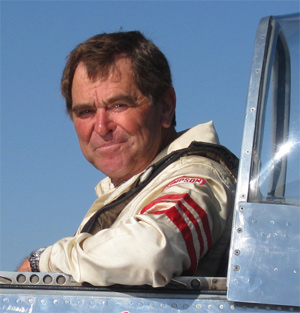
Jimmy Leeward, courtesy of his Facebook page.
I was not there. But I felt the reverberations of that
horrible impact from a thousand miles away. I feel it still. Jimmy
Leeward's accident at the 2011 Reno Air Races was the first time
in over 50 years that a spectator had been killed at an air show or air
race in the
United States.
The accident will no doubt have
long-term repercussions, but no one can say exactly what they might be.
In time, the authorities and accident investigators will come up with a
definitive cause and a thorough summary of the events of that day. My
purpose in writing this article is not to second-guess the National
Transportation Safety Board, or to play
Amateur Investigator. Although I did some accident investigation in the
military, that was not my primary career field. So
I want to discuss some things I do know about -- flying airplanes,
warbirds, airshows, the media, and sociology. They end up being very related
disciplines, especially when a tragic event such as this happens.
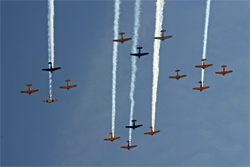 Warbirds, and airshows in general,
have a surprising public image problem -- at least it's surprising to
us. You and I, as pilots,
aircraft owners, mechanics,
warbird aficionados, race fans, aviation photographers,
or
airplane lovers, understand what warbirds are all about. We get it. We attend
airshows and fly in them. We know what's involved when we see a nimble
biplane happily cartwheeling its way across the sky. We can detect the nuances
of an individual performer's aerobatic routine from day to day. We know
how hard it is to maintain a precise multi-ship formation of lumbering
bombers, or perform a complicated rejoin from a high-aspect angle. We
know what Gs feel like, and what kind of physical stamina it takes to
counter them. We know
what immense sacrifice, expense, and hard work is required to field a
WWII fighter or trainer as a competitive racer at Reno. We know how little
financial incentive there is to do so. We sweat and bleed and labor to
restore historic airplanes and bring them back to life. We devote our lives to
maintaining and flying vintage warbirds and helping the public
understand the important roles they played in world history.
Warbirds, and airshows in general,
have a surprising public image problem -- at least it's surprising to
us. You and I, as pilots,
aircraft owners, mechanics,
warbird aficionados, race fans, aviation photographers,
or
airplane lovers, understand what warbirds are all about. We get it. We attend
airshows and fly in them. We know what's involved when we see a nimble
biplane happily cartwheeling its way across the sky. We can detect the nuances
of an individual performer's aerobatic routine from day to day. We know
how hard it is to maintain a precise multi-ship formation of lumbering
bombers, or perform a complicated rejoin from a high-aspect angle. We
know what Gs feel like, and what kind of physical stamina it takes to
counter them. We know
what immense sacrifice, expense, and hard work is required to field a
WWII fighter or trainer as a competitive racer at Reno. We know how little
financial incentive there is to do so. We sweat and bleed and labor to
restore historic airplanes and bring them back to life. We devote our lives to
maintaining and flying vintage warbirds and helping the public
understand the important roles they played in world history.
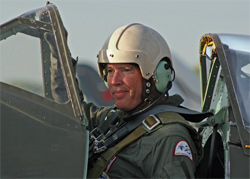 But we are a tiny minority in the
world, and we often forget this. We are so immersed in what we do, and
our circle of friends and associates is so small, that we don't always
realize how the rest of the world sees us. When something
high-visibility happens -- especially something that catches the eye of the TV
media -- we get to find out how little the public knows, and how
terribly they misunderstand what we do. All you have to do is read a
comment thread on any of the larger media outlets' websites after an
airshow accident, and you
begin to feel a sense of despair. How will these people ever
understand? Why do they think we're just a bunch of reckless idiots with more
money than sense?
But we are a tiny minority in the
world, and we often forget this. We are so immersed in what we do, and
our circle of friends and associates is so small, that we don't always
realize how the rest of the world sees us. When something
high-visibility happens -- especially something that catches the eye of the TV
media -- we get to find out how little the public knows, and how
terribly they misunderstand what we do. All you have to do is read a
comment thread on any of the larger media outlets' websites after an
airshow accident, and you
begin to feel a sense of despair. How will these people ever
understand? Why do they think we're just a bunch of reckless idiots with more
money than sense?
Of course, we try to fight the phenomenon
of public ignorance every chance we get. Operators of vintage aircraft often display their
aircraft at airport open-houses and airshows. We give cockpit tours. We host
veterans' groups. We hold public hangar dances. We perform flyovers at
public events and parades. We fly our airplanes in airshows. We
write books. We publish artistic photographs. We give talks and school
presentations. We give interviews to the press.
And it's not enough. It never is. We
can educate and inspire the public until we're blue in the face, but the
next time a vintage aircraft plunges to the ground in a dramatic
fireball, the talking heads on TV will undo our work with fifteen
seconds of breathless hyperbole and shaky cellphone video. To understand
why this is, we first must understand the Prime Directive of the press:
To get ratings, period. A network must endeavor to gain as many
viewers and readers as possible, for that is the single metric that
determines their success.
Not clarity. Not
sensitivity.
Not accuracy. Ratings. It's the equivalent of a commercial truck
driver having "miles driven per day" as his sole criteria -- with
"safety," "speed limits," and "courtesy to the other drivers on the road" be damned.
Needless to say, the carnage on the roads would be incredible. And so it
is with the media.
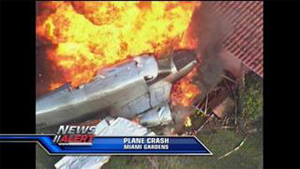 The media's specific problems are
easy to diagnose:
The media's specific problems are
easy to diagnose:
1. They have no accountability,
because there are few serious repercussions if they screw up their
reporting of dramatic events. There
is no loss to their bottom line if they mess up the facts or
misinterpret the events, because in 12 hours' time, they will have
cycled to the next big story, and everyone will have forgotten how badly
that particular story was presented.
2. They employ people whose
knowledge of the world is "one inch deep, and 100 miles wide." There are
no aviation specialists simply sitting around TV studios, waiting in the
wings to comment intelligently on a newsworthy aviation event. (I
know that you have said to yourself, while watching the news, "Why
couldn't they have interviewed ME?") News readers are handed stories to
read, sometimes moments before their broadcasts. This news copy is
written by people under extraordinary time constraints. They get their
information from eyewitnesses, stringers or part-timers, on-scene
reporters (who are often some of the most inexperienced ones), the
internet, and even other media outlets. With only minutes to prepare,
the simple facts get mangled first. Names are wrong. Aircraft types are wrong.
Circumstances are wrong or misunderstood. Bullet points are written
without an understanding of what really happened. But it doesn't matter
to them -- the video footage is dramatic. Perhaps there is fire and
smoke. There is a wrecked flying machine on the ground. There are
traumatized people to look at and interview. That is what brings
in the viewers, not the facts or the context behind the events. It's no wonder we
watch
the TV and seethe with frustration.
"Dirty Laundry" lyrics (excerpt)
Copyright 1982 by Don Henley and Danny
Kortchmar
I make my living off the evening news
Just give me something, something I can use
People love it when you lose
They love dirty laundry
Well I could've been an actor, but I wound up here
I just have to look good, I don't have to be clear
Come and whisper in my ear
Give us dirty laundry
We got the bubble-headed bleach-blonde, comes on at five
She can tell you 'bout the plane crash with a gleam in her
eye
It's interesting when people die
Give us dirty laundry
Can we film the operation? Is the head dead yet?
You know the boys in the newsroom got a running bet
Get the widow on the set
We need dirty laundry |
3. By the time the true experts are
located and interviewed (often hours or days later), the majority of TV
viewers have already tuned out, their opinions of those "dangerous
airshows" and "crazy stunt pilots" having already been reaffirmed. They
have seen what they wanted to see -- 30 seconds of drama and horror.
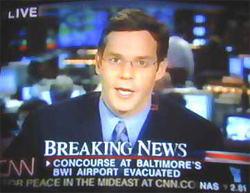 Repeatedly, then, viewers are "taught" by the media that danger lurks in
the sky, that airplanes are tragedies waiting to happen, and that
lunatics are flying over their heads in ancient airplanes. The media does not indoctrinate
people in this way intentionally; they merely allow it to happen because
they do not have time to care about it. They must move on to the next
big story, whether it's a political scandal, a murder, or a hurricane.
Repeatedly, then, viewers are "taught" by the media that danger lurks in
the sky, that airplanes are tragedies waiting to happen, and that
lunatics are flying over their heads in ancient airplanes. The media does not indoctrinate
people in this way intentionally; they merely allow it to happen because
they do not have time to care about it. They must move on to the next
big story, whether it's a political scandal, a murder, or a hurricane.
This cycle repeats itself on a
continuous basis, throughout a viewer's life. By the time the average
child is a young adult, the only thing they know about "small
airplanes" is that they crash, with tragic results. This opinion is
solidified and strengthened through the influence of movies. Hollywood
has even less incentive to present aviation in a realistic light, since
their story lines are pure fiction to start with. It's no wonder that
the rate of new pilot trainees in the USA and elsewhere is down. With a
marketing department like the TV media on the job, we don't have a
chance at overcoming the bad news with good news.
Or do we?
We could give up. We could
retire our airplanes to museums and quietly close our hangar doors. We
could decide that the only safe way to "fly" is by sitting in
front of a computer flight
simulator.
But that's not the natural
inclination of any passionate aviation soul. While we still have the
means and the freedoms to fly vintage (or even non-vintage) airplanes,
it is my fervent hope that airplane owners will now redouble their
efforts to reach out and connect with the public, by whatever safe means
they can do so. Museums must solicit new members. Aviation-related
organizations must figure out new ways to motivate their members and get
new ones -- especially young ones. We must try to educate the public
at every opportunity.
And, most of all, we must operate our airplanes in an
increasingly safe and, dare I say,
thoughtful way.
Here are some examples of what I'm talking about:
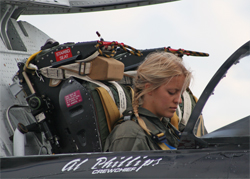 Get really involved.
Instead of simply flying your warbird to an airshow static display and
leaving the airplane unattended all day (and leaving for home the moment
the airfield opens), maybe you could stick around and answer questions
for a while. Give tours, if possible. Let people sit in the airplane.
Tell them about the history of the airplane and its role in our
military, if applicable. Make informative signs for display next to your
airplane. Connect with the people who don't know what they're looking
at, and explain it to them. Swallow your personal ego and make an effort
to educate and inspire those you meet.
Get really involved.
Instead of simply flying your warbird to an airshow static display and
leaving the airplane unattended all day (and leaving for home the moment
the airfield opens), maybe you could stick around and answer questions
for a while. Give tours, if possible. Let people sit in the airplane.
Tell them about the history of the airplane and its role in our
military, if applicable. Make informative signs for display next to your
airplane. Connect with the people who don't know what they're looking
at, and explain it to them. Swallow your personal ego and make an effort
to educate and inspire those you meet.
Give rides. When I was eight
years old, I took a ride in both a Cherokee 140 and a Bell 47 helicopter
on the same day. We had not been in the air for 30 seconds and I already
knew what I was going to do with the rest of my life. Giving rides is
perhaps the best way to turn people on to the majesty of flight, but
make the experience a special one. Again, be thoughtful in the
way you introduce your passenger to flying. Make it a gift they will
cherish for life, not an ordeal they survive. The keywords are
"low-stress, smooth, gentle, fun, and safe." Steep turns, Gs, and
aileron rolls
are fun for you, but they can turn a non-pilot into an airplane hater in
a split-second.
Operate your airplane as if
it's the last one of its type on earth. I often see pilots with vast
experience and admirable flying resumes jump into their airplanes
without the benefit of a preflight inspection, and using no checklists.
They start up and fly away as if they were simply driving their car up
to the corner market. Flying is a more serious endeavor than that,
regardless of the flight time in one's logbook. You should train constantly.
Practice engine-out patterns and other emergency procedures regularly.
Get thorough Flight Reviews from qualified instructors every year.
Challenge yourself to fly to ATP standards, even if you're not an
ATP-rated pilot. Practice professionalism in everything you do. Crank
your pilot skills up a notch -- get new ratings and learn new things
constantly. Attend seminars. Use checklists religiously.
Proper maintenance is not
optional. If you cannot afford to restore and maintain an airplane
properly, you need to sell it to someone who can. The vintage aircraft
community, collectively, is counting on you to do this. Failure affects
everyone.
Do not fly formation if you are not extensively
trained by a qualified instructor. Formation flying is not an
endeavor to take lightly. It is deadly serious, and you simply cannot
teach yourself how to do it safely. In the USA, contact the
Formation And Safety
Training (FAST) organization, or one of its signatory organizations,
such as
NATA, RPA,
CJAA,
T-34s,
Stearman Flight, etc., and take their training. Once you are checked
out, stay current.
Get good training in the first place. Want a good, quick
checkout in a high-performance warbird? It cannot be done. You cannot get a
good
checkout
quickly. The jet warbird community, in particular, is plagued by a
number of instructors who rush their students though rating courses in
inexplicably-short periods of time -- sometimes as short as two flights, plus a checkride. In my experience, the graduates of these courses know next to nothing
about the airplanes they fly, and their confidence and proficiency levels show
it. Some of these people say they only want the ratings for vanity purposes --
so they can "add a line to their airman's certificate." This practice is
questionable at best. (If a person has no intent or
interest in regularly flying the airplane for which they are seeking a rating, then why do
it? Is it an ego thing? Why not just take a demo flight instead?) My concern
stems from the fact that some of these people actually
do
go on to regularly fly the aircraft, and many of these "one-day wonders" are
often ill-equipped, to say the least. With airplanes, your motto ought to be: Do
it right, or don't do it at all.
|
 |
Photo courtesy Michael Westra.
|
Reckless or "showoff" flying
must end, now. A low pass over your buddies is fun to perform
and fun to watch. But it is totally unnecessary, and often leads to
other maneuvers that are not so tame: aileron rolls and barrell rolls, vertical pullups,
wingovers and duster-style reversals, full-up aerobatics... Leave the
airshow flying to the trained airshow performers. Just because your
airplane is capable of high-performance maneuvers does not give you the
right (or instant ability) to perform them, especially at a low altitude near unsuspecting
members of the public. If you think your buddies will like you better
because you are an aerial show-off, you need new friends. When I see
someone flagrantly "shining their ass," I will usually pull the pilot
aside -- respectfully and privately, of course -- and discuss why I
think their actions are a threat to us all. I encourage you to do the
same. You're not being a bad guy or a jerk -- in the big picture, you
are saving lives and protecting our warbird/vintage aircraft community.
Always remember that there are those who can limit our flying
freedoms with the stroke of a pen. I don't want to give them the opportunity. Do you?
There's an old fighter pilot saying:
"You cannot break the record for low flying. You can only
tie it." Which reminds me of another
old fighter pilot saying:
"You can't impress people if you're dead."
What one person does affects
everyone else in this community. It's that small and that scrutinized.
For God's sake, don't encourage
someone to show-off.
If you have chided another pilot for being too tame, you are wrong.
(I have personally been called a derogatory name because I did not
perform an aileron roll after pulling up at the end of the runway
following a low approach. I smiled and nodded at the person, and decided
that my decision was one of the best I'd ever made.) Childish influence
and peer pressure have led more than one pilot to say, "I'll show those
guys!" and someday perform a maneuver for which he is not qualified.
Never dare a pilot to do something. Pilot egos can be inflamed far too
easily.
* * * * *
Regardless of any measures we take,
accidents will happen. This is aviation, after all. So let's talk about
how we can gradually change the way the media reports aviation stories.
Get to know the media
representatives in your area. I fly at an airport where there is a
lot of recreational, warbird, and sport aviation activity. Every year,
we actually invite our local TV personalities to a couple of our fly-ins
and give them rides in our airplanes. (Gentle, straight-and-level
rides, I might add.) We have developed a great relationship with them
over the years, and I think it shows in the respectful, factual way they
report on aviation events in our area. The more reporters who know,
firsthand, what they are talking about, the better. Here's another idea:
Encourage journalists to become pilots! They can produce human-interest
TV segments about their own flight training. How perfect is that? And you
can mentor them as they progress through their training.
Correct them. If nobody tells
the media they made a mistake, they won't know they made one. Call your local
TV or radio station when they make significant mistakes. (Look up each of
the studio numbers and put them in your phone's address book so you can
call right away when you hear something that needs to be corrected.) Ask
to speak to the producer or the news department. Politely state that
there was an error in the report, and ask for an on-air correction.
If you see errors in newspapers,
magazines or web reports, write an email to the writer and the
Editor-In-Chief, coherently explaining what was wrong with the report
and requesting a printed correction. If we do this enough, perhaps media
standards will rise. At the very least, perhaps they will learn a thing
or two about aviation. Getting the basic facts right should be the
minimum level of performance.
Become a journalist yourself!
Write articles for your local newspapers, or become an aviation
subject-matter expert or consultant for a local TV network. Make
yourself their "go-to" person when they need an on-air interview. It's a
long-shot, but maybe you can become the
John Nance of
your local station.
* * * * *
Folks, whether you know it yet or
not, the warbird community is now under greater scrutiny than at any
time in our lifetimes. It is imperative that we be proactive and
professional in dealing with this fact. We must conduct ourselves with
care, take every reasonable precaution, and not tolerate those in our
ranks who undermine our efforts. You can do your part by vowing to
always operate your airplane in a safe manner, maintain it well, and
speak positively about aviation every chance you get. The future of
warbirds in in our own hands.
Buck Wyndham
Editor-In-Chief, WarbirdAlley.com
Comments?
Email me.